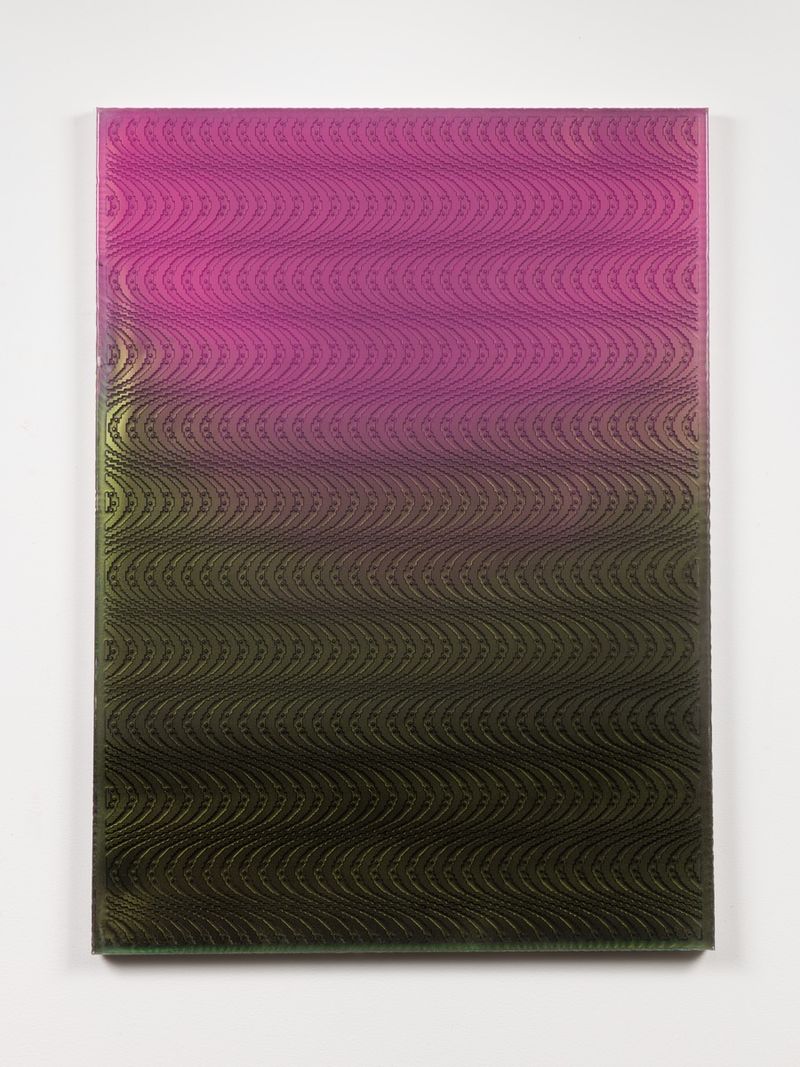“Gotham Jubilee” is an art piece by Ruairiadh O’Connell painted with resin on jesmonite. Created in 2019, the art piece incorporates subtle elements of the Art Deco style that was ubiquitous in the art community in the 1920s. However, instead of merely borrowing the ideas of the Art Deco style, O’Connell uses them to introduce a unique flair to his artwork, thus making a powerful statement. Although, as a whole, the art piece appears to be very harmonious and complete, with very smooth lines and rounded contours, on closer look, one will notice sharp edges and rough lines that burst through the surface. The described characteristic allows relating the art in question to the Art Deco style (Somerville 98). In addition, the bold colors that O’Connell uses in his artwork amplify the impression of the Art Deco style, at the same time developing it into something new.
The sculpture represents an interesting collision of the Art Deco style and the modern genres that have become O’Connell’s trademark characteristic as an artist. On the one hand, colors collide in O’Connell’s artwork, creating a stark contrast between the light and dark areas and, thus, emphasizing the original geometry of the sculpture. On the other hand, the contrast that the colors create is not meant to shock the viewer into paying attention. Instead, it is used to balance out the sharp geometry of the pattern and the rigid lines, introducing smoothness and harmony into the sculpture (Zebracki 2264). As a result, O’Connell’s artwork takes the elements of Art Deco to a new level, allowing them to collide with the modern art and bloom into a new and inspiring notion. The sophistication of the sculpture meets vivid and deep colors, allowing the traditional kaleidoscope of deep greens as the trademark of the Art Deco style to merge with deep magenta in an entirely new and fascinating way (Birnbaum 10).
It is quite remarkable that the references to the Art Deco style coexist with the elements of the abstract art in “Gotham Jubilee” quite peacefully. Indeed, the sculpture only borrows the conceptual elements of the Art deco style without incorporating the ones that allow imbuing a picture with the related notions. As a result, O’Connell’s work only mimics the Art Deco style, hinting at some of its more prominent characteristics with its choice of color and contrast. O’Connell does not simply incorporate the constituents of the Art deco style into his sculpture to create a vague reference; instead, he reimagines the way in which Art Deco artists used color and shade, thus allowing the meaning of the specified expression tool to change and evolve. As a result, the art piece in question no longer possesses the characteristics of a traditional Art deco art work but, instead, merges the genres, creating a new entity.
Indeed, the third dimension introduces a new opportunity into the Art deco style. While at the time of its heyday, Art deco was introduced to general audiences primarily through paintings, the transfer of its elements to resin sculpture allows embracing new opportunities in art and methods of artistic expression. Thus, the artwork gains the depth and insight needed to transform the tropes of the Art Deco style into a new and fascinating work of art. “Gotham Jubilee” speaks volumes with its seemingly limited design and artistic choices, which makes the sculpture a truly fantastic art piece.

Works Cited
Birnbaum, Paula J. “The Exhibitions of the Femmes Artistes Modernes (FAM), Paris, 1931-38.” Artl@ s Bulletin, vol. 8, no. 1, 2019, p. 10.
Castanò, Francesca, and Giangaspare Mingione. “The Space Narrated. The Stained Glass Windows of Pietro Chiesa in the Early Twentieth Century.” Multidisciplinary Digital Publishing Institute Proceedings, vol. 1, no. 9, 2017, pp. 1-9.
Dellapiana, Elena. “Italy Creates. Gio Ponti, America and the Shaping of the Italian Design Image.” Res Mobilis: Revista Internacional de Investigación en Mobiliario y Objetos Decorativos, vol. 7, no. 8, 2018, pp. 19-48.
O’Connell, Ruairiadh. Gotham Jubilee. 2019, Jessica Silverman Gallery.
Ponzio, Angelica. “The [Latin] Modernism of Ponti, Costa and Barragán.” Regionalism, Nationalism & Modern Architecture, vol. 1, 2018, pp. 330-341.
Somerville, Kristine. “Making It Modern: The Art Deco Illustrations of Ernesto García Cabral.” The Missouri Review, vol. 41, no. 2, 2018, pp. 95-107.
Sullivan, Marin R. “Materializing Modernism in Postwar Italy: Fausto Melotti, Gio Ponti, and the 1961 ‘Esposizione Internazionale del Lavoro’.” Art History: Journal of the Association of Art Historians, vol. 39, no. 4, 2016, pp. 720-743.
Zebracki, Martin. “Urban Preservation and the Queerying Spaces of (Un) Remembering: Memorial landscapes of the Miami Beach Art Deco Historic District.” Urban Studies, vol. 55, no. 10, 2018, pp. 2261-2285.